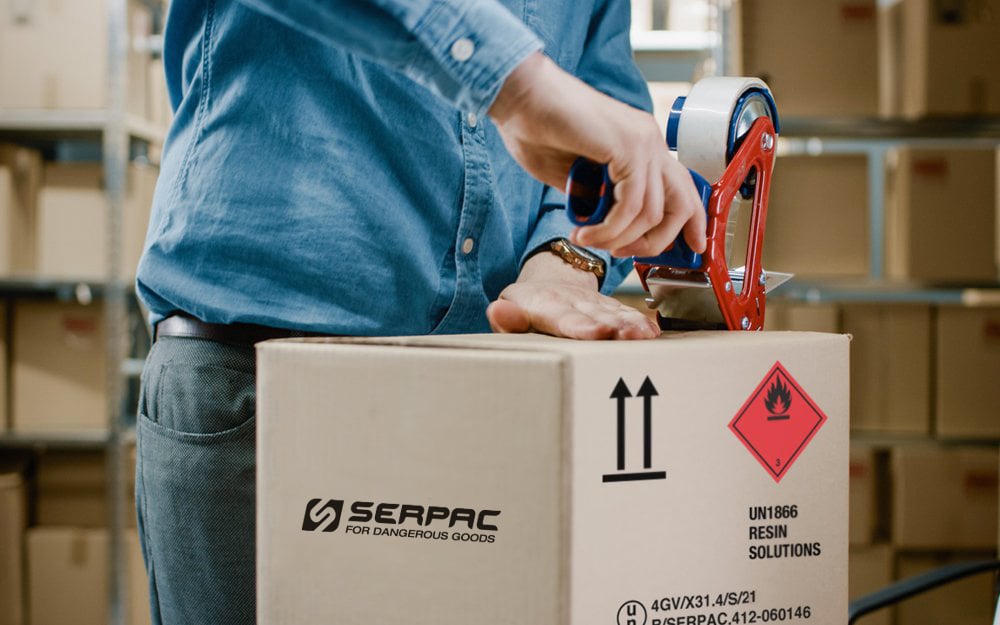How to pack dangerous goods with UN-Certified 4GV fibreboard boxes

Light, versatile, and easy to use. UN-certified 4GV boxes are suitable to ship any kind of object or inner packaging containing solid or liquid materials belonging to packing group I, II, or III.
Furthermore, because they already met UN requirements through certification tests, they are also suitable for shipping by road (ADR), by railroad (RID), by inland waterways (AND), by sea (IMDG), and by air (ICAO-TI / IATA) unless the certification body is not entitled to give the UN mark for all the transport modes.
Certain standards must be met though, and they are compulsory to comply with UN rules for certification. These details are written in fact on the test report, and they are about the use of absorbent and filling material, the minimum distance between the inner packaging and the inside of outer packaging, the bottom and the top of the box, the maximum gross weight of inner packaging(s) and the whole box, and the kind and system of sealing.
To make things clear we drew up a quick guide to be used every time you need to use an UN-certified 4GV box to ship dangerous goods: we started by describing its composing elements, then we’ll show you how to pack dangerous goods with this kind of boxes. Let’s get started!
What to evaluate when using UN-certified 4GV boxes
Let’s start with outer packaging: cardboard boxes. Here you’ll find some essential elements: the first one is the UN certification mark which contains:
- United Nations packaging symbol,
- a code designating the type of packaging - 4GV (V means special packaging),
- a code in two parts: a letter designating the packing group (X stands for P.G. I) and the relative density or, in case of solids, the maximum gross mass allowed,
- a letter indicating the physical state of goods that can be inserted (S stands for “solid”),
- two digits of the year during which the packaging was manufactured,
- a sign indicating the State authorizing the allocation of the mark,
- the name of the manufacturer or other identification of the packaging specified by the competent authority.
Let’s move to absorbing and filling material, which is another distinctive element of UN-certified 4GV boxes for the shipping of dangerous goods. What is commonly used is vermiculite, which is made of mineral-based grains or scales made of microchannels and closed cells: these characteristics make vermiculite suitable for shock and liquid absorption, therefore an ideal cushioning material for UN-certified 4GV boxes.
Nevertheless, the use of vermiculite over a long period may provoke not just a few issues. Let’s point out, for instance, the dust caused by the rubbing among mineral grains, which may make inner packaging(s) dirty if not adequately protected; or the risk of inhaling asbestos fibers contained in some types of vermiculite (Serpac’s vermiculite, on the contrary, is asbestos-free certified). A proper use, that complies with all instructions given, also, might slow down your packing operation. To avoid all these incidents Serpac has designed and put on the market an innovative kit that substitutes vermiculite. This kit contains highly absorbing and cushioning materials which are clean, safe, easy to use, and light.
Finally, let’s not forget about the other essential tools to compose an UN-certified 4GV box for the shipping of dangerous goods: we’re talking here about the PE bag (which is put inside the assembled box and must contain inner packaging(s) surrounded by vermiculite as written in the test report and adhesive tape (that can be used to seal the bag and when requested by the test report also to seal the outer packaging).
How to prepare UN-certified 4GV boxes for dangerous goods
Let’s watch together the correct procedure to prepare and use an UN-certified 4GV box with vermiculite as absorbent and filling material. After reading thoroughly the reference rules for the shipping of dangerous goods by road (ADR), by railroad (RID), by inland waterways (AND), by sea (IMDG), and by air (ICAO-TI / IATA), it is better to check first that the inner packaging gross weight does not exceed the values indicated in the regulations and on the box instructions itself.
Once inner packaging(s) and minimum distances inside the outer box are proof checked, it is possible to insert them inside bags to avoid that they might get dusty with vermiculite. Then we go on with assembling the outer box and closing the bottom, if required, with adhesive tape (prior verification on the test report or on the closing instruction printed on the box). Once the box is assembled you must put a PE bag in it and then you fill it up with vermiculite.
How? Easy: you “just” need to comply with all the instructions written on boxes or given by the suppliers themselves. These instructions are also given in the test report. Once inner packaging(s) are put in place, you must fill the box with vermiculite and close the bag with adhesive tape, cable ties, or any other closing tool. Now you should only close the box (with adequate tape if required) and complete it with labels and marks which are suitable to ship your dangerous goods. Furthermore, we remind you that it is mandatory to comply with the total gross weight of the box that must be equal or less than the values given in the instructions of the used box and the test report. To perform a shipment in compliance with the law you always need to check the correct packing instructions according to the UN number you are shipping and the correct regulation that depends on the mode of transport.
We’re done! Your UN-certified 4GV box is ready to be shipped, respecting rules and regulations that guarantee safety for people working in logistics as well as our environment, your goods, and the used mean of transportation. If you ship according to rules, you will avoid the blocking of your goods, heavy fines, and possible accidents.
